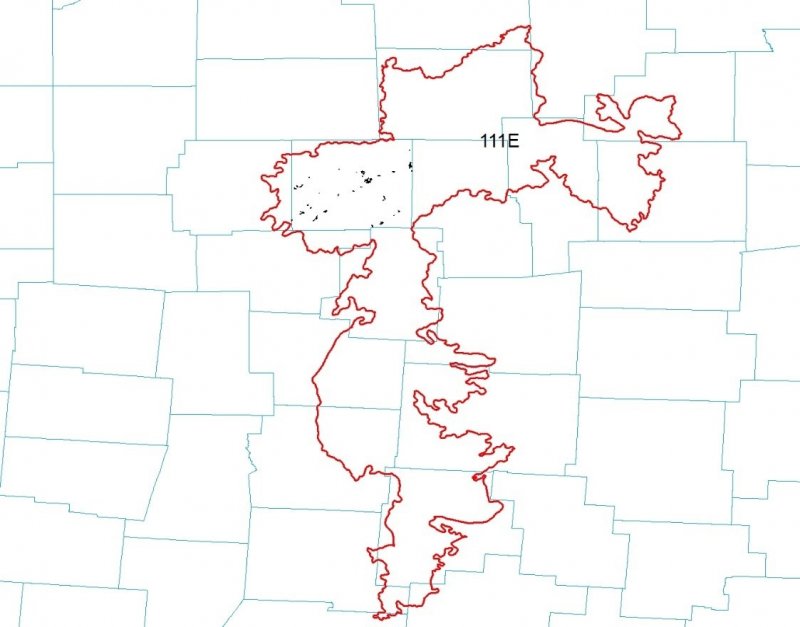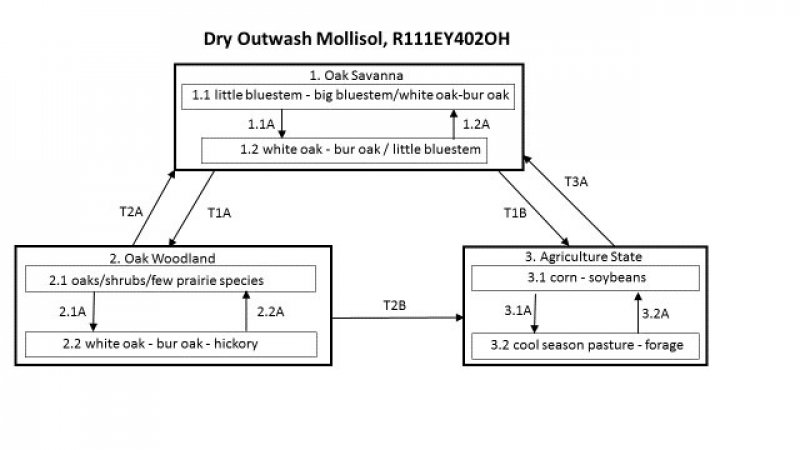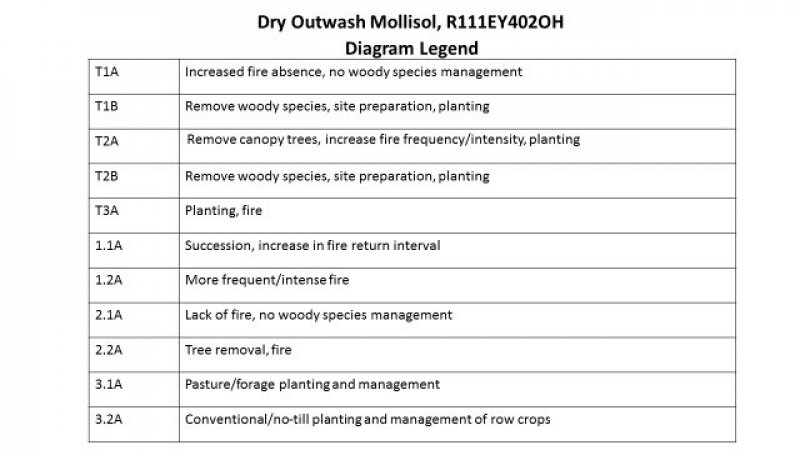
Natural Resources
Conservation Service
Ecological site R111XE402OH
Dry Outwash Mollisol
Last updated: 9/11/2024
Accessed: 12/22/2024
General information
Provisional. A provisional ecological site description has undergone quality control and quality assurance review. It contains a working state and transition model and enough information to identify the ecological site.
MLRA notes
Major Land Resource Area (MLRA): 111X–Indiana and Ohio Till Plain
111E – Indiana and Ohio Till Plain, Eastern Part. Most of this area is in the Till Plains Section of the Central Lowlands Province of the Interior Plains. The northeast tip of the area is in the Southern New York Section of the Appalachian Highlands. The entire area has been glaciated. It is dominated by ground moraines that are broken in places by kames, lake plains, outwash plains, terraces, and stream valleys. Narrow, shallow valleys commonly are along the few large streams in the area. Elevation ranges from 580 to 1,400 feet (175 to 425 meters), increasing gradually from west to east. Relief is mainly a few meters, but in some areas hills rise as much as 100 feet (30 meters) above the adjoining plain.
The extent of the major Hydrologic Unit Areas (identified by four-digit numbers) that make up this MLRA is as follows: Scioto (0506), 33 percent; Muskingum (0504), 31 percent; and Western Lake Erie (0410), 28 percent; Upper Ohio (0503), 5 percent; and Southern Lake Erie (0411), 3 percent. The headwaters of many rivers in central Ohio, including the Vermillion, Black Fork, Sandusky, Little Scioto, and Olentangy Rivers, are in this MLRA.
This MLRA is underlain by late Devonian shale and sandstone. Surficial materials include glacial deposits of till, glaciolacustrine sediments, and outwash from Wisconsin and older glacial periods.
Classification relationships
Major Land Resource Area (USDA-Natural Resources Conservation Service, 2006)
USFS Ecological Regions (USDA, 2007):
Sections –Central Till Plains, Beech Maple (222H), Western Glaciated Allegheny Plateau (221F)
Subsections – Allegheny Plateau (221Fa), Bluffton Till Plains (222Ha), Miami-Scioto Plain – Tipton Till Plain (222Hb)
NatureServe Systems anticipated (NatureServe, 2011): Agriculture - Cultivated Crops and Irrigated Agriculture, Agriculture – Pasture/Hay, North-Central Interior Dry-Mesic Oak Forest and Woodland
LANDFIRE Biophysical Settings anticipated (USGS, 2010): North-Central Interior Dry-Mesic Oak Forest and Woodland
Ecological site concept
The historic plant community of the Dry Outwash Mollisol ecological site is an oak savanna. This site is characterized by the co-dominance of oak trees, especially white and bur oak, and tall prairie grass species, particularly big bluestem and little bluestem. This site was maintained by frequent, low intensity fires, often with a return interval of no more than 5 years, which allowed the co-dominance of growth types to persist. Stand replacing fires occurred approximate every 200 years. Insect and small mammal herbivory would impact local composition and dominance of the species in a localized and infrequent nature.
Associated sites
| R111XE401OH |
Wet Outwash Mollisol Soils are very poorly or poorly drained |
|---|---|
| F111XE403OH |
Outwash Upland Soil surface is lighter in color and can is very poorly to somewhat poorly drained |
| F111XE404OH |
Dry Outwash Upland Soil surface is lighter in color and is moderately well drained or dried |
Similar sites
| R111XE401OH |
Wet Outwash Mollisol Soils are very poorly or poorly drained |
|---|
Table 1. Dominant plant species
| Tree |
(1) Quercus alba |
|---|---|
| Shrub |
Not specified |
| Herbaceous |
(1) Schizachyrium scoparium |
Click on box and path labels to scroll to the respective text.


